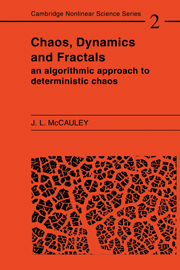Book contents
- Frontmatter
- Dedication
- Contents
- Preface
- Miscellaneous Frontmatter
- Introduction
- 1 Flows in phase space
- 2 Introduction to deterministic chaos
- 3 Conservative dynamical systems
- 4 Fractals and fragmentation in phase space
- 5 The way to chaos by instability of quasiperiodic orbits
- 6 The way to chaos by period doubling
- 7 Introduction to multifractals
- 8 Statistical mechanics on symbol sequences
- 9 Universal chaotic dynamics
- 10 Intermittence in fluid turbulence
- 11 From flows to automata: chaotic systems as completely deterministic machines
- Bibliography
- Index
Preface
Published online by Cambridge University Press: 05 October 2013
- Frontmatter
- Dedication
- Contents
- Preface
- Miscellaneous Frontmatter
- Introduction
- 1 Flows in phase space
- 2 Introduction to deterministic chaos
- 3 Conservative dynamical systems
- 4 Fractals and fragmentation in phase space
- 5 The way to chaos by instability of quasiperiodic orbits
- 6 The way to chaos by period doubling
- 7 Introduction to multifractals
- 8 Statistical mechanics on symbol sequences
- 9 Universal chaotic dynamics
- 10 Intermittence in fluid turbulence
- 11 From flows to automata: chaotic systems as completely deterministic machines
- Bibliography
- Index
Summary
The study of deterministic chaos by iterated maps goes back to the mathematician H. Poincaré, but did not become a part of theoretical physics until after M. Feigenbaum's discovery, and analysis by a renormalization group method, of universal critical exponents at the transition to chaos in a class of one-dimensional maps (one-dimensional maps had also been studied as paradigms of chaos in higher-dimensional systems by Lorenz and Grossmann). Since the discovery of universality at transitions to chaos, and the observation of period-doubling sequences by A. Libchaber and his co-workers in fluid mechanics experiments, much has been written about deterministic chaos and fractals. However, one thing must be stated in the beginning: although this book is primarily about iterated maps, the method of analysis and choice of emphasis make it very different from all of the others. It is written for those who not only want an introduction to modern developments in nonlinear dynamics and fractals, but also want to understand the following questions: How can a deterministic trajectory be unpredictable? How can nonperiodic chaotic trajectories be computed? Is information loss avoidable or necessary in a deterministic chaotic system? Are deterministic chaotic orbits random? What are multifractals, and where do they come from? Why do we study iterated maps instead of differential equations?
Information
- Type
- Chapter
- Information
- Chaos, Dynamics, and FractalsAn Algorithmic Approach to Deterministic Chaos, pp. xiii - xxiiPublisher: Cambridge University PressPrint publication year: 1993
